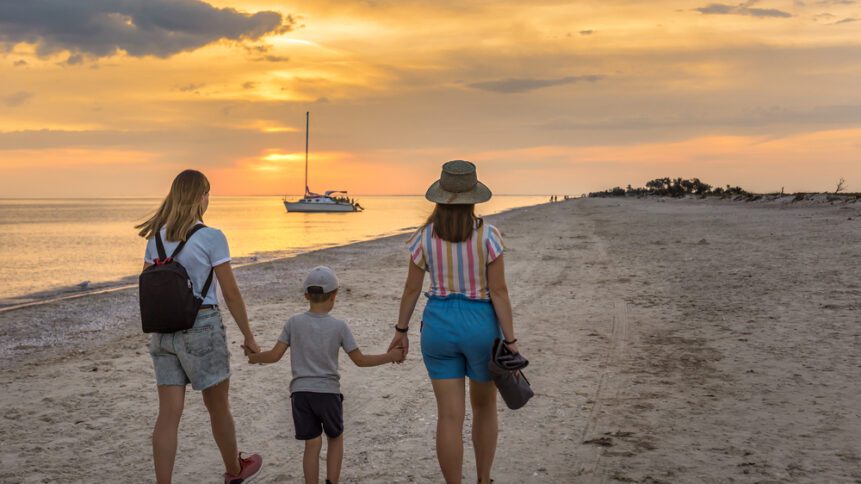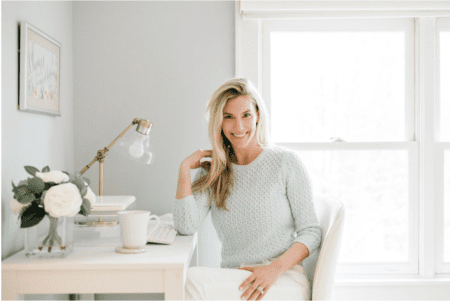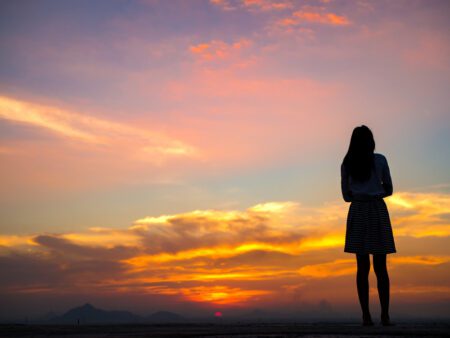
When I finally got pregnant on my first round of IVF (three unsuccessful IUIs in my wake), I didn’t tell my best friend. Nicole knew that my partner and I were trying to become parents. When you’re in a same-sex relationship, it’s a lot harder to keep the baby-making business private. At least one other person has to be involved, whether it’s your sperm donor or your reproductive endocrinologist.
Still, conventional wisdom says you should wait to tell people you’re pregnant until you’re three months along and the chance of miscarriage is lower. Back then, I thought following the rules would help me become a mom. The unspoken bargain I made with the universe was: I may be queer and have a blocked fallopian tube, but I promise I’ll do everything else right.
“The verdict is still out,” I told Nicole.
That much was true. My first blood test showed an hCG level of 9. Anything below 5 is considered not pregnant; anything above 25 is a green light to sign up for emails from the Baby Center that tell you what type of fruit your fetus currently resembles. At 9, I was solidly pregnant…ish.
I was terrified about what the next test would reveal, but it was kind of cool having a Secret Good Thing inside my body.
*
Of course, conventional wisdom about sharing is hanging on by a thread in our social media-saturated culture. Posts in my Twitter feed currently include “I had a kissing dream last night” and “I’m in a really bad place mentally right now.”
Over on Instagram, I can view a felted denim jacket upcycled by a friend, and watch an influencer mom pack lunches for her 12 children.
The darkness of Twitter and the aspirationalism of Instagram often leave me with whiplash, but on big and small scales, most people make at least a bit of their personal lives public. The questions are: What bit? How public? For what reasons? How does this apply to what’s in my uterus? The darkness of Twitter and the aspirationalism of Instagram often leave me with whiplash, but on big and small scales, most people make at least a bit of their personal lives public. The questions are: What bit? How public? For what reasons? How does this apply to what’s in my uterus?
*
Some people find freedom in privacy. A friend who was diagnosed with Stage 4 cancer kept it under wraps for years, although she also wrote about her experience anonymously on a blog and Twitter. She moved through the physical world in a healthy-looking body without worrying about pitying glances and unsubstantiated comments like “Did you know carrots cure cancer?” while finding solidarity and community in the metaverse.
Maybe it’s because I spent approximately a decade in the closet, but secrecy no longer sits well with me, personally. Historically, queer people have been told—directly and indirectly—to shut up about our desires and our lives. Even now, every act of holding hands in public is a small rebellion. When I write about my life, I’m insisting on visibility. It sounds like a political choice, but it’s more like an itch that, once noticed, demands to be scratched.
People are advised not to announce their pregnancies too early so that they don’t have to reveal a possible miscarriage. If that spares them pain, that’s fair. But this advice is twofold— it’s also to spare other people the burden of witnessing someone’s pain. People are advised not to announce their pregnancies too early so that they don’t have to reveal a possible miscarriage. If that spares them pain, that’s fair. But this advice is twofold— it’s also to spare other people the burden of witnessing someone’s pain.
When I miscarried twins at nine weeks, I told everyone.
I bled at work and in the car on the way to my fertility doctor, and all over a dress when my period came back with a roar months later. My body couldn’t be contained, and neither could my soul. I was seized with an Alanis-like need to “remind you of the mess you left when you went away,” although I’m not sure who the “you” was. The twins I miscarried? The cold and confusing world of fertility treatment? All those smug pregnant women cooing at their bumps? Definitely, definitely them.
Writing about all of it, first in blog posts, later in a book, was a way of exorcizing what was inside me, a kind of emotional bloodletting, and it allowed me—a lifelong control freak—to control the narrative. Sort of. I can’t know whether people read my words with sadness or commiseration or schadenfreude or annoyance, but I was able to tell myself what I needed to hear: My babies never made it to this world, but they existed, and they were mine.
*
This year, they would have turned eleven. I do think of them, but I’m also usually focused on seven-year-old, Dash, whom my partner and I adopted as an infant. He is four feet and two inches of energy, joy, and curiosity—and also sensitivity, rage, and fart jokes. This year, they would have turned eleven. I do think of them, but I’m also usually focused on seven-year-old, Dash, whom my partner and I adopted as an infant.
A few years into parenthood, partially but never fully healed from our intense road to becoming moms, my partner and I decided to try to make Dash a big brother. Now in our early forties, adoption was our first stop. We cautiously hoped that being seasoned parents might make us more appealing to expectant mothers seeking families for their unborn babies. We hoped it would be easier this time around.
We were wrong.
Three years and four failed adoption matches later, we’re trying to make our peace with being moms of one excellent kid. He has a cousin. He has close friends at school, and the girls who live next door are almost like sisters. He’ll be okay.
A decade ago, when I was wearing my longing on my sleeve and my blog, I sometimes lamented that I couldn’t just pretend that I was a happy child-free queer artist. I loved (and love) being a queer artist. It was the part of my identity that didn’t rely on approval from the mainstream or sperm from Donor #5762. But I’d shown my hand: I’d let my desire out of my heart, out of the closet, and into the world.
And then I did it again, writing my way through each of our disrupted adoptions.
*
Things are more peaceful now. I’m not waiting for my hCG numbers to double, or for our attorney’s office to call with news about whether an expectant mom decided to keep her baby. I’m writing this in the midst of a semi-lazy summer. A hot breeze ruffles the leaves outside my window. Soon I’ll go pick up Dash from swim camp, where he’s learning to float on his back, and the sun is turning his skin almond-brown. I’m trying to lean into the good life I already have, and now that the grief has dried up—mostly—it’s not that hard. All I have to do is look around. It’s harder to know what to say about quiet, hard-won happiness, though.
As any good Brené Brown follower knows, vulnerability is ultimately good for us. I can’t change the fact that I put my big longing and my big heartbreak out there. The former connected us to our first adoption match. A friend of a friend knew a woman who’d just had a baby and wanted to find adoptive parents for him. We drove four hours north and after many intense, heart-wrenching conversations, came home with Wolf. He stayed with us for two weeks before his parents changed their minds about adoption.
After I wrote about that experience, I got the chance to interview artist and author Shira Spector, whose gorgeous graphic novel Red Rock Baby Candy chronicles her own experience with infertility and making peace with mothering an only child. She read my essay and we bonded immediately about the deep wounds and love of funky eyewear we shared.
Connection with other mothers and would-be mothers is more than a consolation prize. It’s proof that whatever we do as humans, we rarely do it alone, as lonely as it feels.
Thank you for riding this roller coaster with me, I often tell friends. And I mean it. I mean Thank you for listening to me scream. Not just inside my heart, but out loud.
Contributor
Cheryl Klein
Cheryl Klein is the author of Crybaby: Infertility, Illness, and Other Things That Were Not the End of the World (Brown Paper Press), as well as two works of fiction. She co-edits MUTHA Magazine and lives with her family in Los Angeles. Follow her on Twitter @cherylekleinla and Instagram @cherylekleinstories.

Listen to stories, share your own, and get feedback from the community.


















